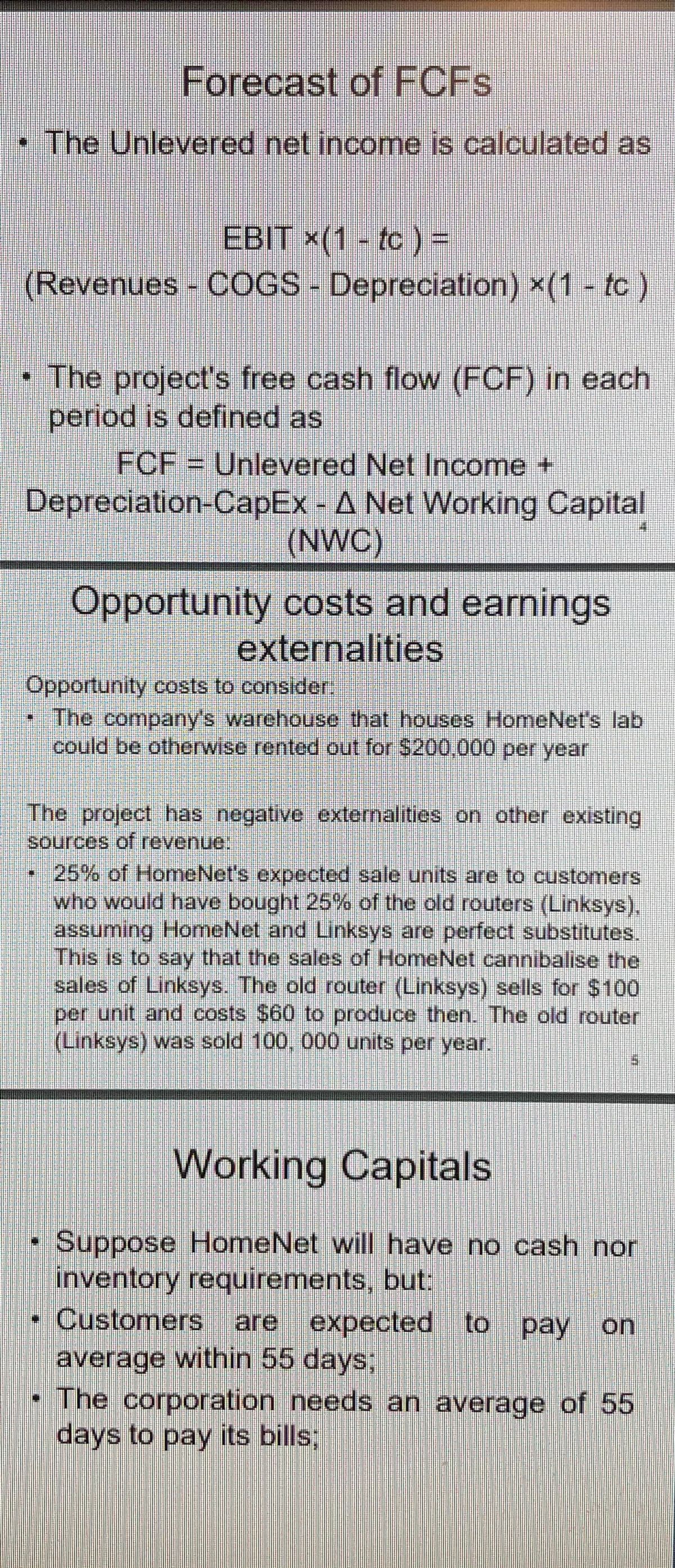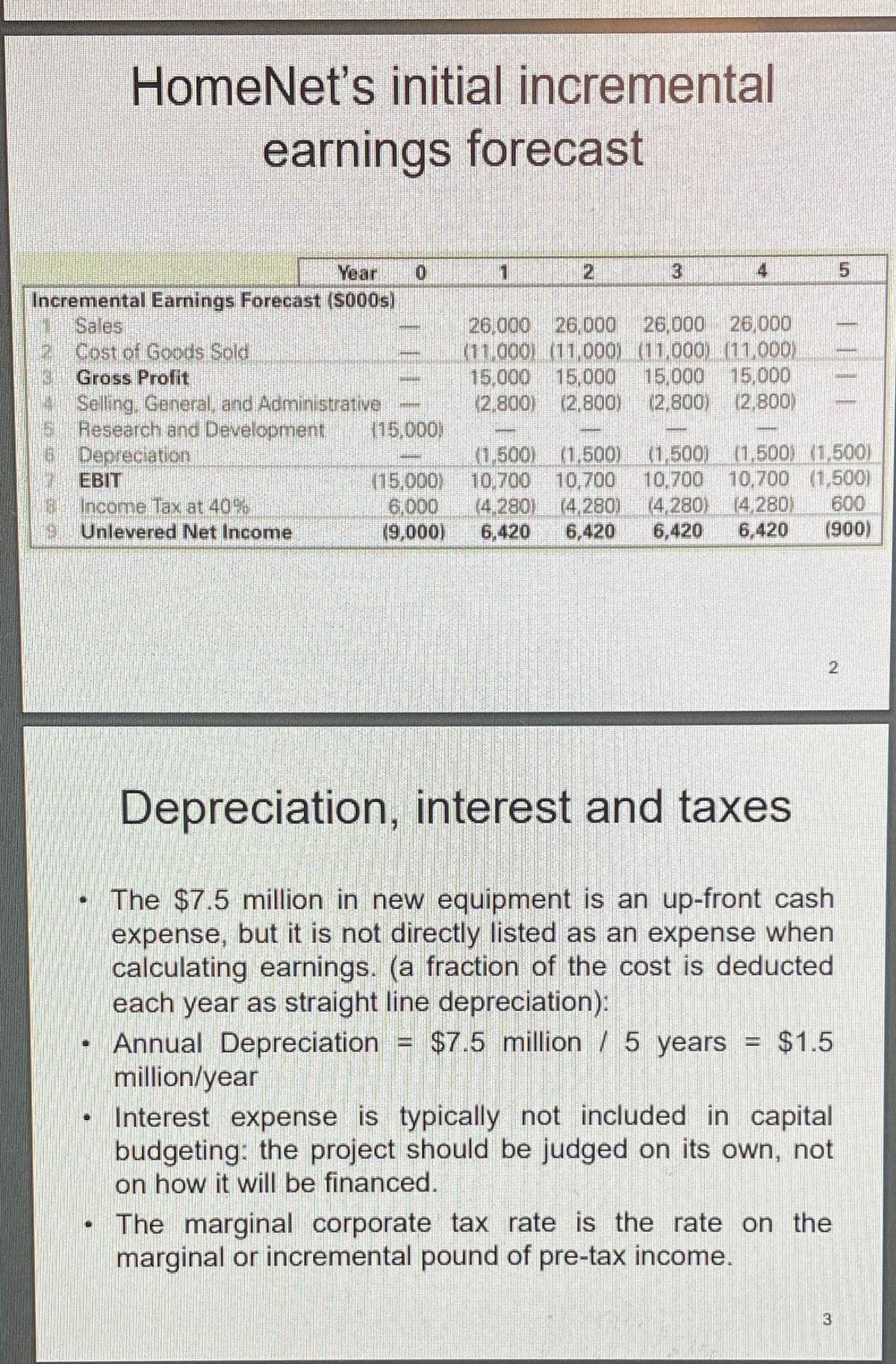Fundamentals of Financial Management (MindTap Course List)
15th Edition
ISBN:9781337395250
Author:Eugene F. Brigham, Joel F. Houston
Publisher:Eugene F. Brigham, Joel F. Houston
Chapter4: Analysis Of Financial Statements
Section: Chapter Questions
Problem 24P: Income Statement for Year Ended December 31, 2018 (Millions of Dollars) Net sales 795.0 Cost of...
Related questions
Question
Suppose the HomeNet's Cost of Capital is
12%, use
investment appraisal methods to analyse this
according to the rules mentioned

Transcribed Image Text:Forecast of FCFS
• The Unlevered net income is calculated as
EBIT ×(1 - tc ) =
(Revenues COGS- Depreciation) x(1 tc)
• The project's free cash flow (FCF) in each
period is defined as
FCF = Unlevered Net Income +
Depreciation-CapEx - A Net Working Capital
(NWC)
Opportunity costs and earnings
externalities
Opportunity costs to consider.
The company's warehouse that houses HomeNet's lab
could be otherwise rented out for $200,.000 per year
The project has negative externalities on other existing
sources of revenue.
25% of HomeNet's expected sale units are to customers
who would have bought 25% of the old routers (Linksys),
assuming HomeNet and Linksys are perfect substitutes.
This is to say that the sales of HomeNet cannibalise the
sales of Linksys. The old router (Linksys) sells for $100
per unit and costs $60 to produce then. The old router
(Linksys) was sold 100, 000 units per year.
Working Capitals
Suppose HomeNet will have no cash nor
inventory requirements, but:
Customers are expected to pay on
average within 55 days;
• The corporation needs an average of 55
days to pay its bills;

Transcribed Image Text:HomeNet's initial incremental
earnings forecast
Year
2
15
Incremental Earnings Forecast (S000s)
Sales
2 Cost of Goods Sold
3Gross Profit
Selling. General, and Administrative
6 Research and Development
6 Depreciation
2 EBIT
0Income Tax at 40%
Unlevered Net Income
26,000 26,000 26,000 26,000
(11,000) (11,000) (11,000) (11,000)
15,000 15,000
(2,800) (2,800) (2,800)
15,000 15,000
(2,800)
115,000)
(15,000)
6,000
(9,000)
(1,500) (1,500) (1,500) (1,500) (1,500)
10,700 10,700
(4,280) (4,280)
6,420
10,700 10,700 (1,500)
(4,280) (4,280)
6,420
600
(900)
6,420
6,420
2
Depreciation, interest and taxes
• The $7.5 million in new equipment is an up-front cash
expense, but it is not directly listed as an expense when
calculating earnings. (a fraction of the cost is deducted
each year as straight line depreciation):
Annual Depreciation = $7.5 million / 5 years = $1.5
million/year
Interest expense is typically not included in capital
budgeting: the project should be judged on its own, not
on how it will be financed.
The marginal corporate tax rate is the rate on the
marginal or incremental pound of pre-tax income.
3
Expert Solution
This question has been solved!
Explore an expertly crafted, step-by-step solution for a thorough understanding of key concepts.
Step by step
Solved in 2 steps

Knowledge Booster
Learn more about
Need a deep-dive on the concept behind this application? Look no further. Learn more about this topic, finance and related others by exploring similar questions and additional content below.Recommended textbooks for you

Fundamentals of Financial Management (MindTap Cou…
Finance
ISBN:
9781337395250
Author:
Eugene F. Brigham, Joel F. Houston
Publisher:
Cengage Learning


Fundamentals of Financial Management (MindTap Cou…
Finance
ISBN:
9781337395250
Author:
Eugene F. Brigham, Joel F. Houston
Publisher:
Cengage Learning
